 Today I would like to share the recipe for my Weight Loss Bath. The question occasionally arises in my practice if it is possible to lose weight through Voodoo. This is a difficult question to answer since Voodoo, like most religions and spiritual practices, was developed before dieting and weight loss were a concern for many people. In fact, today in West Africa, Haiti and many other places where traditional African and Afro-Caribbean faiths are practiced it is considered desirable, attractive and even healthy to be somewhat overweight. However in our modern world many of us struggle with weight issues and there is no question that obesity can cause serious health problems so I feel it is perfectly acceptable to give ourselves a spiritual edge when trying to lose weight. The following is a bath that I designed years ago while living in Spain for the purpose of losing weight quickly and in a healthy way. It has worked tremendously well for me and for others over the years.
Today I would like to share the recipe for my Weight Loss Bath. The question occasionally arises in my practice if it is possible to lose weight through Voodoo. This is a difficult question to answer since Voodoo, like most religions and spiritual practices, was developed before dieting and weight loss were a concern for many people. In fact, today in West Africa, Haiti and many other places where traditional African and Afro-Caribbean faiths are practiced it is considered desirable, attractive and even healthy to be somewhat overweight. However in our modern world many of us struggle with weight issues and there is no question that obesity can cause serious health problems so I feel it is perfectly acceptable to give ourselves a spiritual edge when trying to lose weight. The following is a bath that I designed years ago while living in Spain for the purpose of losing weight quickly and in a healthy way. It has worked tremendously well for me and for others over the years.
Before getting into the ingredients and preparation of the bath, I’d like to talk a bit about the circumstances under which I first developed and used it as it is an interesting story. In the fall of 2001, I was 18 years old and beginning my first semester at an American university in Madrid, Spain. As part of the program, it was a requirement that I live with a Spanish family. I was placed with a single woman in her late 50’s named Charo. Needless to say, I was fascinated by all occult topics and of course practiced Voodoo even in those days. Charo found this incredibly odd to say the least and after a dramatic flip out scene after I had burned a candle that I anointed with honey and cinnamon and made a fruit offering to some saints, I decided that it was best to do any future rituals in secret. In retrospect, I realize that I should have been more sensitive to Charo’s feelings on the subject of Voodoo and spiritualism, but having been raised in those traditions I didn’t fully realize at that young age how certain people perceive such topics. As spiritual people, we should strive to be respectful and create an environment where all people can be comfortable while we try to educate on spiritual matters and teach tolerance and respect.
At the time, I was several pounds overweight which I needed to lose quickly so I decided that a discrete way I could go about giving myself a spiritual edge would be to create a bath for this purpose. So at night, I filled a big glass pitcher with water and several ingredients, but I forwent the step of boiling the bath, as I could not access the kitchen without rousing suspicion. I said a blessing over the bath and allowed it to sit and steep until morning. When Charo was at her job at the Ministry of Economics, I took the blessed herbal infusion in the bath room and after my morning shower I poured it over my head. I repeated the bath once each month for the three months that I stayed with Charo and by the time I returned to the US I had lost 50 pounds. I would like to add that I did this without following any form of diet as I had to eat what Charo prepared for me, but I did get more exercise than usual as I spent hours exploring Madrid which is a beautiful city. I have recommended this bath to others over the years and have seen it produce impressive results.
You will need:
A large pitch or container
A cinnamon stick or ground cinnamon
Nutmeg
Dried Basil
Dried Thyme
Dried mint or spearmint
A paper and a pen
Add all the ingredients to the pitcher. Use one teaspoon of each. Fill the pitcher almost to the top with water.
Write your goal weight on the piece of paper and rest it on top of the pitcher if possible, if not, place it next to it.
Hold your hands over the pitcher and say, “With the help of this bath, may I reach my ideal weight quickly and safely. So be it!”
Allow the bath to sit overnight and the next morning either add it to your bath water or pour it over your head in the shower. I recommend repeating the bath once a month on the same day each month while you are trying to lose weight. Also before taking this bath, it would be a good idea to take a simple salt water bath for purification to start with a clean base. Also, cinnamon can be a skin irritant, so if you have sensitive skin, it might be advisable not to attempt this bath but rather try a weight loss spell instead.
I hope you have enjoyed this post and I hope this bath helps in your weight loss efforts. I would advise you to follow whatever weight loss plan you normally would and allow this bath to give you a spiritual edge and turbocharge your weight loss.
As always I wish you peace, happiness and abundant blessings!
Mabon or Harvest Home
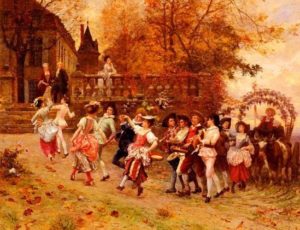 Autumn has long been my favorite season when the fruits of the Earth and harvested, the colorful leaves paint the landscape and the air is literally permeated with magic. Now that we are entering this most special of seasons, I thought we could discuss another important fall festival: Mabon or Harvest Home. We have previously mentioned, Lammas, which falls of August 1st and is a celebration of the early Harvest. Mabon is the second of the three harvest festivals (Lammas, Mabon and Samhain) celebrated by Wiccans and neo-Pagans and it celebrates the fullness of the harvest in the spirit of giving thanks to the Earth for the bountiful fruits and vegetables that she has provided. It falls of the Autumnal Equinox which this year is September 22nd.
Autumn has long been my favorite season when the fruits of the Earth and harvested, the colorful leaves paint the landscape and the air is literally permeated with magic. Now that we are entering this most special of seasons, I thought we could discuss another important fall festival: Mabon or Harvest Home. We have previously mentioned, Lammas, which falls of August 1st and is a celebration of the early Harvest. Mabon is the second of the three harvest festivals (Lammas, Mabon and Samhain) celebrated by Wiccans and neo-Pagans and it celebrates the fullness of the harvest in the spirit of giving thanks to the Earth for the bountiful fruits and vegetables that she has provided. It falls of the Autumnal Equinox which this year is September 22nd.
 Mabon is a rather recently codified holiday, although certainly based on ancient principles and celebrations. When the Wiccan Sabbaths and wheel of the year were compiled in the middle of the 20th century, the autumnal equinox was definitely an important event, but it was not until the 1970’s that famed scholar and expert in neo-Paganism Aidan Kelley gave this holiday the name Mabon based on the character from Welsh mythology Mabon ap Modron. Much of the traditions surrounding Mabon are borrowed from the English celebration of Harvest Home where country folk would gather to celebrate and give thanks for the full bounty of the harvest. The American celebration of Thanksgiving resembles in many respects the English Harvest Home celebrations of previous centuries and even today many churches have fall harvest festivals where congregants bring fruits, vegetables and baked goods to share with others and often a prayer or blessing is recited. Wiccans and Neo-Pagans have reclaimed the ancient celebration of the harvest in the form of Mabon and on this day many place offerings of fresh fruit and vegetables on their altars and perform rituals of thanksgiving to the Earth either communally or solitarily.
Mabon is a rather recently codified holiday, although certainly based on ancient principles and celebrations. When the Wiccan Sabbaths and wheel of the year were compiled in the middle of the 20th century, the autumnal equinox was definitely an important event, but it was not until the 1970’s that famed scholar and expert in neo-Paganism Aidan Kelley gave this holiday the name Mabon based on the character from Welsh mythology Mabon ap Modron. Much of the traditions surrounding Mabon are borrowed from the English celebration of Harvest Home where country folk would gather to celebrate and give thanks for the full bounty of the harvest. The American celebration of Thanksgiving resembles in many respects the English Harvest Home celebrations of previous centuries and even today many churches have fall harvest festivals where congregants bring fruits, vegetables and baked goods to share with others and often a prayer or blessing is recited. Wiccans and Neo-Pagans have reclaimed the ancient celebration of the harvest in the form of Mabon and on this day many place offerings of fresh fruit and vegetables on their altars and perform rituals of thanksgiving to the Earth either communally or solitarily.
If you are interested in celebrating Mabon or Harvest Home, it’s really quite simple to put together a service of thanksgiving. If you have a home altar, you can simply place some seasonal fruits and vegetables on it and light a white candle and say a prayer of thanksgiving for all the blessings you have received and in particular for the abundance that the Earth has given us in the autumnal harvest. If you don’t have a permanent altar you can set up a makeshift altar on any table or flat surface. Also, in the spirit of community, share some fresh fruits or vegetables with friends and family or even bake some pumpkin-spice cupcakes or another fall inspired recipe and share them with others. The act of sharing food, which is so simple and widely practiced, is a spiritual ritual in and of itself as it fosters a sense of love, friendship and community.
I hope you have enjoyed this post and I hope you do something to recognize and enjoy this most beautiful of seasons. As always I wish you peace, happiness and abundant blessings!
Amish Friendship Bread Money Ritual
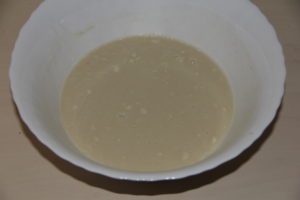 Amish Friendship Bread has been around for decades, the recipe having made its first appearance on the internet in early 90’s and having been circulated via Xeroxed copy and in hand written form prior to that. Despite the name, this sweet, cake-like quick bread does not have its origins in Amish communities and perhaps derives its name from the similarities it bears with several coffee cakes and sweet breads that are typical of Amish cookery. The Friendship Bread is circulated among friends, family and acquaintances much in the style of a chain letter with the recipe as well as a cup of sour dough starter being passed from person to person. People often share pieces of the prepared sweetbread as well. The idea behind this practice is to foster sharing, friendship and indulge in a fun communal activity. I remember my mother receiving ziplock bags full of sourdough starter from her work colleagues and making the bread at home. The finished product is a moist, fluffy cake-like bread with a mild cinnamon and vanilla flavor.
Amish Friendship Bread has been around for decades, the recipe having made its first appearance on the internet in early 90’s and having been circulated via Xeroxed copy and in hand written form prior to that. Despite the name, this sweet, cake-like quick bread does not have its origins in Amish communities and perhaps derives its name from the similarities it bears with several coffee cakes and sweet breads that are typical of Amish cookery. The Friendship Bread is circulated among friends, family and acquaintances much in the style of a chain letter with the recipe as well as a cup of sour dough starter being passed from person to person. People often share pieces of the prepared sweetbread as well. The idea behind this practice is to foster sharing, friendship and indulge in a fun communal activity. I remember my mother receiving ziplock bags full of sourdough starter from her work colleagues and making the bread at home. The finished product is a moist, fluffy cake-like bread with a mild cinnamon and vanilla flavor.
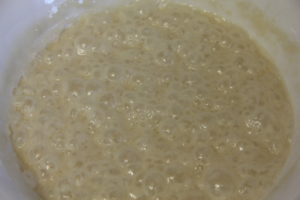 I recently remembered the Amish friendship bread and the chain letter type of tradition surrounding it and it occurred to me that a magical ritual could easily be developed based on this practice. I have designed the following money and good luck ritual based on the Amish Friendship Bread recipe as a means of conjuring wealth for yourself and for your circle for friends. The more the recipe and starter circulate, the more wealth and good luck are generated. I recently put the spell into practice with some friends and not only did the recipe produce a delicious cake, but I have already begun to feel the benefits of the spell.
I recently remembered the Amish friendship bread and the chain letter type of tradition surrounding it and it occurred to me that a magical ritual could easily be developed based on this practice. I have designed the following money and good luck ritual based on the Amish Friendship Bread recipe as a means of conjuring wealth for yourself and for your circle for friends. The more the recipe and starter circulate, the more wealth and good luck are generated. I recently put the spell into practice with some friends and not only did the recipe produce a delicious cake, but I have already begun to feel the benefits of the spell.
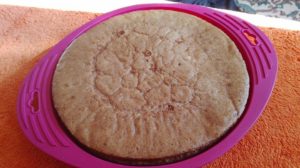 Below are the ingredients and instructions for both the recipe and the money drawing ritual associated with it. Please give it a try and bring wealth and luck into your life and the lives of your loved ones!
Below are the ingredients and instructions for both the recipe and the money drawing ritual associated with it. Please give it a try and bring wealth and luck into your life and the lives of your loved ones!
Amish Friendship Money Bread
Day 1 – Receive the starter from a friend or follow the recipe for the starter below.
Day 2 – Stir for three minutes while saying “Money, money come to me.”
Day 3 – Stir for three minutes while saying “Money, money come to me.”
Day 4 – Stir for three minutes while saying “Money, money come to me.”
Day 5 – Add 1 cup each flour, sugar and milk and stir for three minutes while saying “Money, money come to me.”
Day 6 – Stir for three minutes while saying “Money, money come to me.”
Day 7 – Stir for three minutes while saying “Money, money come to me.”
Day 8 – Stir for three minutes while saying “Money, money come to me.”
Day 9 – Stir for three minutes while saying “Money, money come to me.”
Day 10 – Add 1 cup flour, 1 cup sugar and 1 cup milk. Divide into 4 containers, with 1 cup each for three of your friends and 1 cup for your own loaves. As you separate the batter say, “May this bread bring luck and money to me and to all those to make and eat it.” Give friends the instructions for Day 1 through Day 10 and the following recipe for baking the bread.
After removing the 3 cups of batter, combine the remaining cup of Amish Friendship Bread starter with the following ingredients in a large bowl:
2/3 cup oil
3 eggs
1/2 tsp. salt
1 tsp. vanilla
1 to 1 1/2 tsp. cinnamon
1 cup sugar
2 cups flour
1 1/4 tsp. baking powder
1/2 tsp. baking soda
Using a fork beat by hand until well blended. Grease two loaf pans with butter, sprinkle with sugar instead of flour.
Decorate the tops of the loaves with green or yellow colored sugar in the shape of a dollar or euro sign, or both!
Bake at 325 degrees F for 45 minutes to 1 hour (individual oven temperatures vary). Cool 10 minutes, remove from pans. Makes two loaves of Amish Friendship Money Bread.
As you eat the bread imagine wealth flowing into your life.
Amish Friendship Money Bread Starter
This is the Amish Friendship Bread Starter Recipe that you’ll need to make the Amish Friendship Bread if you have not already received a cup of started from a friend. It is very important to use plastic or wooden utensils and plastic or glass containers when making this. Do not use metal at all!
Ingredients:
1 pkg. active dry yeast
1/4 cup warm water (110 degrees F)
1 cup all-purpose flour
1 cup white sugar
1 cup warm milk (110 degrees F)
Before beginning the process below, say a blessing over the ingredients. Hold your hand over the ingredients and say, “May this bread bring wealth and luck to me and to all those who make and eat it. Money, money come to me. So be it!”
Directions:
In a small bowl, dissolve the yeast in warm water for about 10 minutes. Stir well while saying “Money, money come to me.”
In a 2 quart glass or plastic container, combine 1 cup sifted flour and 1 cup sugar. Mix thoroughly or the flour will get lumpy when you add the milk.
Slowly stir in warm milk and dissolved yeast mixture. Loosely cover the mixture with a lid or plastic wrap. The mixture will get bubbly. Stir for three minutes while saying, “Money, money come to me.” Consider this Day 1 of the cycle, or the day you receive the starter.
For the next 10 days handle starter according to the instructions above for Amish Friendship Money Bread.
P’chum Ben: A Celebration of the Ancestors
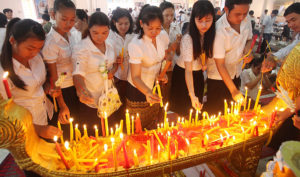 I attended elementary school and high school in Amherst, Massachusetts where there is a large Cambodian community and every April we would have a school celebration for Cambodian New Year where students would perform traditional Cambodian dances. My favorite was always the Monkey Dance in which the participants would fly acrobatically through the air imitating monkeys. We would also eat Cambodian foods and listen to Khmer folktales. Years later, when I was working as a 5th grade classroom assistant and tutor, we visited a local Buddhist temple and gave food offerings to the monks and learned about Cambodian Buddhist traditions. Despite my enjoyment of Cambodian New Year all throughout my childhood, I have only recently learned about another important Khmer holiday: P’chum Ben, The Festival of the Dead. Today I would like to discuss this fascinating annual observance in honor of the ancestors which shares so much in common with other festivals of the dead around the world yet is also undeniably unique.
I attended elementary school and high school in Amherst, Massachusetts where there is a large Cambodian community and every April we would have a school celebration for Cambodian New Year where students would perform traditional Cambodian dances. My favorite was always the Monkey Dance in which the participants would fly acrobatically through the air imitating monkeys. We would also eat Cambodian foods and listen to Khmer folktales. Years later, when I was working as a 5th grade classroom assistant and tutor, we visited a local Buddhist temple and gave food offerings to the monks and learned about Cambodian Buddhist traditions. Despite my enjoyment of Cambodian New Year all throughout my childhood, I have only recently learned about another important Khmer holiday: P’chum Ben, The Festival of the Dead. Today I would like to discuss this fascinating annual observance in honor of the ancestors which shares so much in common with other festivals of the dead around the world yet is also undeniably unique.
P’chum Ben marks the end of a fifteen day period known as Pak Ben which falls during the tenth month of the lunar calendar which coincides with September and early October according to the Western calendar. During this period, Cambodian Buddhists bring offerings of food to monks at local temples. Sweets and fruits, especially banana leaves stuffed with sweet rice, are the preferred offerings. Devout Buddhists ornately arrange these offerings on platters often with flowers and other decorations and bring them to the local temple. On P’chum Ben, monks give speeches and recite ancient chants in the sacred Pali language all night and families offer prayers for their departed loved ones going back several generations. There is also a carnival like atmosphere on P’chum Ben with elaborate family feasts, music and a spirit of communal celebration in towns and cities across Cambodia and in Khmer communities around the world.
P’chum Ben shares many similarities with other festivals throughout the world that honor the dead such as the Chinese Hungry Ghosts Festival, the Japanese Obon, the Haitian Fet Ghede, the Mexican Día de los Muertos and the Pagan observance of Samhain. All of these observances are times to honor the dead and all share the custom of making offerings and reciting prayers to ensure that loved ones have a happy and peaceful afterlife. Much in line with the Chinese and Mexican traditions, there is a belief that during P’chum Ben, the gates of the afterlife open and spirits are allowed to return to Earth. P’chum Ben shares with the Hungry Ghost festival the tradition of making offerings to ghosts who have nobody to pray for them and who therefore might be angry or distraught. In Cambodia, there exists the custom on mixing rice with sesame seeds and sprinkling it in front of temples as an offering to Hungry Ghosts and wandering spirits. In Khmer Buddhist theology, it is not the offering themselves that are believed to be consumed by the dead, but rather it is the act of presenting these offerings to monks in an act of charity and piety that creates merit that helps the dead. This concept is unique to the celebration of P’chum Ben and differs from Chinese folk religion in which the offerings are believed to benefit the dead directly, although in some parts of Cambodia similar beliefs exist. In addition to the solemn rituals carried out in pagodas across Cambodia, P’chum Ben also shares the carnival-like atmosphere typical of the Mexican Day of the Dead with music, family gatherings and outdoor celebrations.
This year P’chum Ben begins on September 30th and lasts until October 2nd. If you’d like to honor your ancestors during this time you could make food offerings at home as well as light candles for them. In Cambodia, small red and yellow candles are traditionally used. If you have a Buddhist temple nearby, you might consider making a visit and, in the true spirit of P’chum Ben, making a gift of food to the monks or even a donation of money to the charity of your choice in the name of your ancestors, a good deep from which you and your ancestors will benefit tremendously. The most important lesson to learn from P’chum Ben and indeed from all festivals that honor the dead is that life, in one form or another, is eternal and we are all connected to the spirit world through our loved ones that have crossed over and it’s important to take some time now and then to remember and honor them.
I hope you have enjoyed this post and as always I wish you peace, happiness and abundant blessings!
Lammas: A Celebration of the Early Harvest
With July drawi ng to a close, summer is half over and we are fast approaching my favorite season: Fall! So, today I thought we could discuss the subject of harvest festivals and Lammas or Lughnasadh in particular which falls of the 1st of August. This is the first of three Sabbaths observed by Wiccans and other Neo-Pagans that celebrate the beginning of the Harvest and the end to the growing season. Lammas/Lughnasadh is the early harvest festival, Mabon (September 21) celebrates the full bounty of the Harvest and Samhain or Halloween marks the end of the harvest season and the beginning of the dark half of the year. Samhain is also considered the Wiccan and Pagan New Year and in Voodoo Fet Ghede which falls of the same date is also considered the New Year. While I do not follow Wicca and do not consider myself Pagan, as a spiritually inclined person, I do understand the importance of being in harmony with the seasons of the year, although admittedly, Autumn is by far my favorite and my energy and happiness levels surge this time of year!
ng to a close, summer is half over and we are fast approaching my favorite season: Fall! So, today I thought we could discuss the subject of harvest festivals and Lammas or Lughnasadh in particular which falls of the 1st of August. This is the first of three Sabbaths observed by Wiccans and other Neo-Pagans that celebrate the beginning of the Harvest and the end to the growing season. Lammas/Lughnasadh is the early harvest festival, Mabon (September 21) celebrates the full bounty of the Harvest and Samhain or Halloween marks the end of the harvest season and the beginning of the dark half of the year. Samhain is also considered the Wiccan and Pagan New Year and in Voodoo Fet Ghede which falls of the same date is also considered the New Year. While I do not follow Wicca and do not consider myself Pagan, as a spiritually inclined person, I do understand the importance of being in harmony with the seasons of the year, although admittedly, Autumn is by far my favorite and my energy and happiness levels surge this time of year!
All ancient cultures and societies lived their lives according to the seasons of the year. The ancient Celts were no exception. As an agrarian society, their festivals and celebrations coincided with import periods of sewing crops and harvesting. There was also a plethora of rituals to ensure plentiful crops and to give thanks for a bountiful harvest. Lughnasadh marked the beginning of the harvest season and was seen as a joyful time when farmers would reap the rewards of their efforts and also the beginning of a period of intense labor require to bring in the harvest. These traditions survived into modern times in the British Isles in the form of an observance called Loaf Mass, which popularly became known as Lammas. On the 1st of August, country dwellers would make a loaf of bread out of freshly harvested wheat and bring it to the local church to be blessed and then shared among friends and neighbors. Churches would also ring bells to welcome in the harvest season. It was a time of celebration and a kick off to the fall season.
There are many ways to celebrate Lammas and to ring in the harvest season and the beginning of autumn. The observance of Lammas tends to be highly individual. I have a Pagan friend who simply sits outside in nature and eats sunflower or pumpkin seeds while bathing in the energy of the day. In accordance with the British tradition, I bake a loaf of bread and leave it on my altar as an offering to my ancestors and saints. I also harvest flowers on this day from my garden to be burnt as offerings at my annual Halloween celebration. Observing Lammas can be as simple as taking a few moments to walk outside and be in harmony with the changing seasons and recognizing the importance of the Earth in providing life sustaining crops, a reality which people often forget in this modern world.
I hope you have enjoyed this post and that you are having an amazing summer or winter for my friends in the Southern Hemisphere. As always I wish you peace, happiness and abundant blessings!